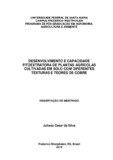| dc.creator | Silva, Juliano Cesar da | |
| dc.date.accessioned | 2019-06-19T19:13:31Z | |
| dc.date.available | 2019-06-19T19:13:31Z | |
| dc.date.issued | 2019-03-08 | |
| dc.identifier.uri | http://repositorio.ufsm.br/handle/1/17056 | |
| dc.description.abstract | The addition of copper by anthropic activities influences the metal content of the soil, making this element potentially toxic to agricultural species. The dynamics of copper in the soil is influenced by the physical and chemical characteristics of the soil as well as the activity of symbiotic microorganisms associated with different cultures. Therefore, this work had as objective to analyze the influence of the contamination by copper, evaluating its dynamics in soils with different textures in the cultivation of soybean and sorghum. In order to meet this objective, three experiments were developed: the first evaluated the development of agricultural plants cultivated in soil with different textures and copper contents; the second tested the phytoextractive capacity of agricultural plants cultivated under different percentages of clay and how this affected copper levels in contaminated soils and the third determined the interference of a nitrogen fixing bacteria in the development of sorghum in soil contaminated with copper. The results showed that the soybean and sorghum crops are negatively influenced by the addition of copper in the soil, and its content is affected by soil texture. Soils with 17.5% of clay allow greater availability of copper under conditions of lower Pseudo-total. The more clayey the soil, the greater the amplitude between available copper and Pseudo-Total. The increase of copper in the soil has a positive interaction with the increase of this metal in the soybean grain, so areas contaminated with copper can be considered unsuitable for the cultivation of this species. The inoculation with Azospirillum brasilense allows greater development of the aerial part of the sorghum and reduces the content of copper in aerial part. | eng |
| dc.description.sponsorship | Coordenação de Aperfeiçoamento de Pessoal de Nível Superior - CAPES | por |
| dc.language | por | por |
| dc.publisher | Universidade Federal de Santa Maria | por |
| dc.rights | Attribution-NonCommercial-NoDerivatives 4.0 International | * |
| dc.rights.uri | http://creativecommons.org/licenses/by-nc-nd/4.0/ | * |
| dc.subject | Sorghum bicolor | por |
| dc.subject | Glycine max | por |
| dc.subject | Textura de solo | por |
| dc.subject | Azuspirillum brasilense | por |
| dc.subject | Metal pesado | por |
| dc.subject | Soil texture | eng |
| dc.subject | Azuspirillum brasilense | eng |
| dc.subject | Heavy metal | eng |
| dc.title | Desenvolvimento e capacidade fitoextratora de plantas agrícolas cultivadas em solo com diferentes texturas e teores de cobre | por |
| dc.title.alternative | Development and phytoextract capacity of agricultural plants cultivated in soil with different textures and copper contents | eng |
| dc.type | Dissertação | por |
| dc.description.resumo | A adição de cobre pelas atividades antrópicas influencia os teores do metal no solo, tornando este elemento potencialmente tóxico às espécies agrícolas. A dinâmica do cobre no solo sofre influência das características físicas e químicas do solo bem como da atividade de microrganismos simbióticos associados a diferentes culturas. Desse modo, este trabalho teve como objetivo analisar a influência da contaminação por cobre, avaliando sua dinâmica em solos com diferentes texturas no cultivo da soja e do sorgo. Para atender esse objetivo desenvolveu-se três experimentos, no qual o primeiro avaliou o desenvolvimento de plantas agrícolas cultivadas em solo com diferentes texturas e teores de cobre; O segundo testou a capacidade fitoextratora de plantas agrícolas cultivadas sob diferentes percentuais de argila e como isso afetou os teores de cobre nos solos contaminados; O terceiro determinou a interferência de uma bactéria fixadora de nitrogênio no desenvolvimento do sorgo em solo contaminado com cobre. Os resultados evidenciaram que a cultura da soja e do sorgo sofrem influência negativa pela adição de cobre no solo, e o teor deste é afetado pela textura do solo. Solos com 17,5 % de argila possibilita maior disponibilidade de cobre em condições de menor Pseudo-total. Quanto mais argiloso o solo, maior é amplitude entre cobre disponível e Pseudo-Total. O acréscimo de cobre no solo tem interação positiva com o aumento deste metal no grão da soja, assim áreas contaminadas com cobre podem ser consideradas impróprias para o cultivo desta espécie. A inoculação com Azospirillum brasilense possibilita maior desenvolvimento da parte aérea do sorgo e reduz teor de cobre em parte aérea. | por |
| dc.contributor.advisor1 | Silva, Rodrigo Ferreira da | |
| dc.contributor.advisor1Lattes | http://lattes.cnpq.br/0974234816299860 | por |
| dc.contributor.referee1 | Flora, Lisandra Pinto Della | |
| dc.contributor.referee1Lattes | http://lattes.cnpq.br/0125226860208396 | por |
| dc.contributor.referee2 | Rosa, Marcia Matsuoka | |
| dc.contributor.referee2Lattes | http://lattes.cnpq.br/9460537156796309 | por |
| dc.creator.Lattes | http://lattes.cnpq.br/0049498928599932 | por |
| dc.publisher.country | Brasil | por |
| dc.publisher.department | Agronomia | por |
| dc.publisher.initials | UFSM | por |
| dc.publisher.program | Programa de Pós-Graduação em Agronomia - Agricultura e Ambiente | por |
| dc.subject.cnpq | CNPQ::CIENCIAS AGRARIAS::AGRONOMIA | por |
| dc.publisher.unidade | UFSM Frederico Westphalen | por |



